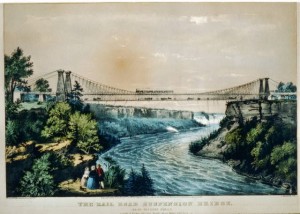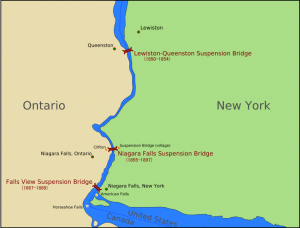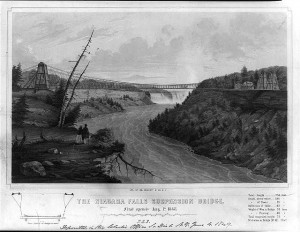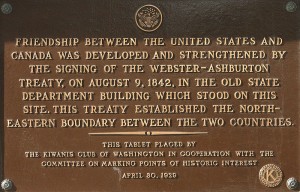A Canadian newspaper is concerned about reports that 1) a Union officer crossed into Canada to try to force a deserter back to the U.S. and that 2) a couple Canadian/British soldiers went to the U.S. side of the river, had some drinks, and while under the influence got signed up for the Union army.
From The New-York Times February 9, 1862:
TROUBLE AT THE NIAGARA FALLS SUSPENSION BRIDGE.
From the Toronto Leader, Feb. 4.
Two occurrences have been reported to us, on credible authority, which seem to render it desirable that a guard should be placed over the Suspension Bridge, at the Falls of Niagara. The facts are these: Last Sunday an American recruiting officer, accompanied by two or three other persons, came over the Suspension Bridge into Canada, with a view of forcibly and illegally taking back a deserter from the Federal army. The fugitive protested against the attempt being carried out, and soliciting the assistance of the bystanders, was rescued from the hands of men whose intention it was, if they had got their own way, to have violated the right of asylum in Canada, in the person of this deserter. We need not say that there is no law under which an American deserter, taking refuge in Canada, can be compelled to return. The only provision existing between the two countries, for the extradition of fugitives who have escaped from the one to the other, is contained in the Ash burton Treaty; and that only brings criminals charged with certain specified crimes withing its purview.
The other occurrence which has been related to us is of a different nature, though it is one which, like the former, seems to require the exercise of some vigilance for which there is no provision at the Suspension Bridge. It is stated that a non-commissioned officer and a private of the Thirtieth Regiment, belonging to a detachment stationed at St. Catharines, passed over the bridge on Saturday evening; and, having been induced to drink, were enlisted into the American army while in a state of intoxication. On Monday morning, it is added, they were sent to Buffalo. At the present time, when the presence of troops on both sides of the Niagara River renders a repetition of such occurrences as these liable to occur, it would seem advisable that some preventive guard should be placed at the Bridge.
And I thought Virginia Governor John Letcher made an interesting point about the federal government coercing seceding states back into the Union. Here Union coercion operates in a foreign country and against foreign nationals.
It wasn’t exactly another Battle of Lundy’s Lane (War of 1812), but I like the pluck of the Canadian bystanders helping out the deserter.
The Leader says its sources are credible, so I guess these incidents could have happened, so shortly after the resolution of Trent Affair. There is certainly evidence that Union deserters went to Canada, and, as Canada’s Foreign Affairs and International Trade Department points out, about 100 years later American draft dodgers would once again find asylum in Canada during the Vietnam war.
After its completion the Niagara Falls Suspension Bridge became a terminus on the Underground Railroad as American slaves sought freedom in Canada. Although completed in stages Charles Ellet, Jr. built the the temporary bridge that was opened in 1848.
The Webster–Ashburton Treaty was signed in 1842.
Winfield Scott led a brigade of Americans at Lundy’s Lane.
The map and the photo of the plaque are licensed by Creative Commons.




